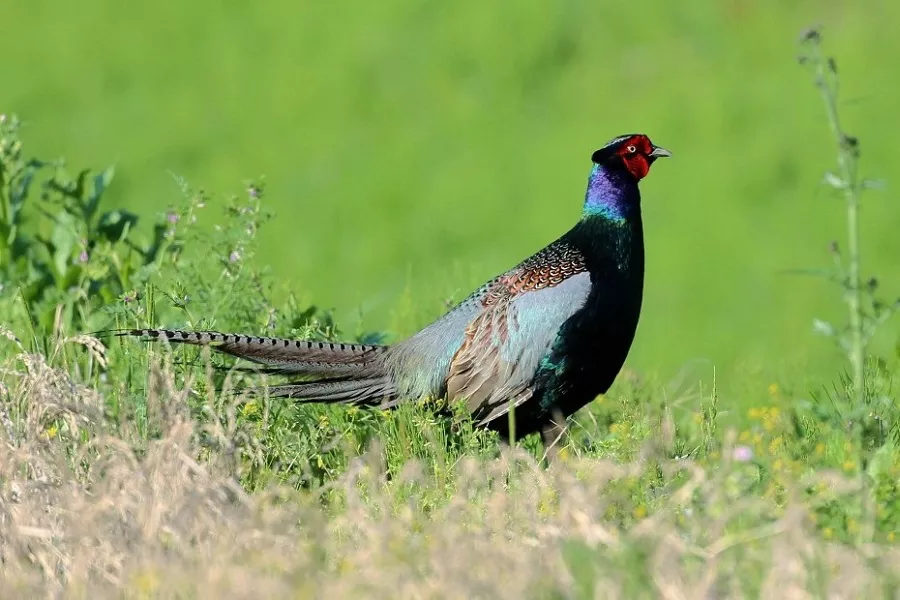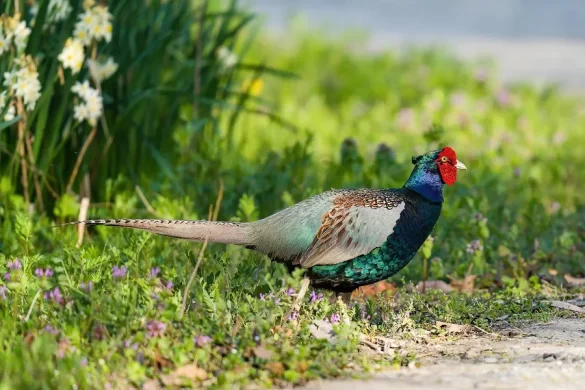Japan, a country known for its rich culture, history, and natural beauty, has a deep appreciation for its wildlife. One of the most celebrated aspects is Japan’s national bird, the Green Pheasant (Phasianus versicolor). This article explores the significance, characteristics, and cultural importance of the Green Pheasant, delving into why it was chosen as Japan’s national bird and its role in the ecosystem.
National Bird of Japan: The Green Pheasant
1. Physical Characteristics
The Green Pheasant is a striking bird, known for its vibrant and iridescent plumage. Males are particularly colorful, with a metallic green body, a bluish-purple neck, and a crimson face. They have long, elegant tail feathers, which add to their majestic appearance. Females, on the other hand, are more subdued in color, with mottled brown feathers that provide excellent camouflage.

Green Pheasant
2. Habitat and Distribution
The Green Pheasant is native to Japan and is found throughout the country, from the main islands of Honshu, Shikoku, and Kyushu to the smaller islands. It inhabits various environments, including forests, grasslands, and agricultural areas. This adaptability to different habitats has contributed to its widespread presence in Japan.
3. Behavior and Diet
Green Pheasants are ground-dwelling birds that prefer to forage on the forest floor. They are omnivorous, feeding on a diet that includes seeds, grains, insects, and small invertebrates. Their foraging behavior plays a vital role in seed dispersion and pest control, making them an integral part of the ecosystem.
4. Reproduction and Lifespan
Breeding season for Green Pheasants typically begins in spring. Males engage in elaborate courtship displays, showcasing their colorful plumage and performing intricate dances to attract females. After mating, females lay eggs in nests on the ground, which are well-hidden to protect them from predators. The incubation period lasts about three weeks, after which chicks hatch and are cared for by the mother.
Cultural Significance
Green Pheasant Symbolism in Japanese Culture
The Green Pheasant holds a special place in Japanese culture and is often associated with virtues such as nobility, beauty, and protection. It appears in various aspects of Japanese art, literature, and folklore, symbolizing good fortune and prosperity. The bird is also believed to be a messenger of the gods, further elevating its cultural status.
Representation in Art and Literature
In Japanese art, the Green Pheasant is a common motif, depicted in traditional paintings, ceramics, and textiles. Its image can be found in ancient scrolls and modern artworks alike, showcasing its enduring appeal. Literature, too, features the Green Pheasant in numerous tales and poems, highlighting its beauty and significance in Japanese storytelling.
Role in Festivals and Traditions
Various festivals and traditions in Japan celebrate the Green Pheasant. During these events, people honor the bird through dances, songs, and ceremonial offerings. These festivals not only pay homage to the national bird but also promote awareness and conservation efforts to protect this cherished species.
Conservation Status and Efforts
Current Threats
Despite its cultural importance, the Green Pheasant faces several threats in the wild. Habitat loss due to urbanization, agricultural expansion, and deforestation poses significant challenges to its survival. Additionally, predation by introduced species and hunting have further impacted its population.
Conservation Initiatives
To address these threats, various conservation initiatives have been implemented in Japan. These efforts include habitat restoration projects, legal protection measures, and public awareness campaigns. Organizations and government agencies work together to monitor populations, protect critical habitats, and promote sustainable practices to ensure the Green Pheasant’s survival.
Success Stories
Several success stories highlight the positive impact of conservation efforts on the Green Pheasant population. For instance, reforestation projects have helped restore habitats, leading to an increase in bird numbers in certain areas. Community-based initiatives have also played a crucial role in fostering a sense of responsibility and stewardship among local residents.
The Ecological Role of the Green Pheasant
Seed Dispersal
As a forager, the Green Pheasant contributes to seed dispersal, aiding in the regeneration of plant species. By consuming fruits and seeds and excreting them in different locations, these birds help maintain the biodiversity of their habitats.
Pest Control
Green Pheasants also play a vital role in controlling insect populations. Their diet includes various insects and small invertebrates, which helps regulate these populations and prevent them from becoming pests. This natural pest control is particularly beneficial in agricultural areas, where the birds can help protect crops from damage.
Indicator Species
The presence of Green Pheasants can be an indicator of ecosystem health. Because they require specific habitat conditions to thrive, their population trends can provide insights into the state of their environment. A healthy Green Pheasant population often signifies a well-balanced and functioning ecosystem.
Historical Background
Evolution and Ancestry
The Green Pheasant’s ancestry dates back millions of years, with its evolutionary lineage closely tied to other pheasant species. Fossil records and genetic studies indicate that these birds have a long and complex evolutionary history, adapting to various environmental changes over time.
Introduction to Japan
The exact timeline of the Green Pheasant’s introduction to Japan is not well-documented, but it is believed to have been present in the region for thousands of years. Its ability to adapt to different habitats likely facilitated its spread across the Japanese archipelago.
Role in Historical Japan
In historical Japan, the Green Pheasant was not only admired for its beauty but also held practical value. It was hunted for its meat and feathers, which were used in traditional clothing and ceremonial items. Despite this, the bird’s population remained stable due to sustainable hunting practices and the respect it commanded in society.
Why the Green Pheasant is Japan’s National Bird
Selection Process
The selection of the Green Pheasant as Japan’s national bird was not a random decision. In the 1940s, a committee of ornithologists, historians, and cultural experts convened to choose a bird that represented Japan’s natural and cultural heritage. After careful consideration, the Green Pheasant was selected for its distinctive appearance, widespread presence, and cultural significance.
Symbolic Value
The Green Pheasant embodies many qualities that resonate with Japanese values. Its elegance and grace reflect the country’s appreciation for beauty, while its resilience and adaptability symbolize the strength and perseverance of the Japanese people. Additionally, its role in folklore and mythology enhances its symbolic value, making it a fitting emblem for the nation.
Public Perception
Public perception of the Green Pheasant is overwhelmingly positive. Surveys and polls indicate that many Japanese people feel a strong connection to the bird and view it as a symbol of national pride. This widespread admiration further solidifies its status as Japan’s national bird.
Green Pheasant in Modern Japan
Wildlife Tourism
The Green Pheasant attracts wildlife enthusiasts and birdwatchers from around the world. Various nature reserves and parks in Japan offer opportunities to observe these birds in their natural habitat. Wildlife tourism not only boosts the local economy but also raises awareness about the importance of conservation.
Research and Study
Ongoing research and study of the Green Pheasant contribute to a better understanding of its behavior, ecology, and conservation needs. Scientists and researchers conduct field studies, genetic analyses, and population monitoring to gather valuable data that informs conservation strategies.
Green Pheasant in Popular Media
The Green Pheasant continues to appear in popular media, including television shows, movies, and advertisements. Its image is often used to promote environmental awareness and cultural heritage. This visibility helps keep the bird in the public eye and reinforces its importance in Japanese society.
Conclusion
The Green Pheasant, Japan’s national bird, is a symbol of the country’s rich natural and cultural heritage. Its vibrant plumage, ecological significance, and deep-rooted presence in Japanese culture make it a bird worth celebrating and protecting. As Japan continues to face environmental challenges, the Green Pheasant serves as a reminder of the importance of conservation and the need to cherish and safeguard the nation’s wildlife for future generations. Through continued efforts and a collective commitment to preserving nature, the Green Pheasant can continue to thrive and inspire both Japanese people and visitors from around the world.
FAQs
1. What is the state bird of Tokyo?
The state bird of Tokyo is the Grey Heron (Ardea cinerea). This elegant bird is often seen around wetlands and rivers in the Tokyo area.
2. What is the National tree of Japan?
The national tree of Japan is the Japanese Cedar (Cryptomeria japonica), known locally as “sugi.” This tree is highly valued in Japan for its wood and is commonly planted around temples and shrines.
3. What is the National flower of Japan?
The national flower of Japan is the Cherry Blossom (Sakura). These flowers are celebrated across the country, especially during the spring season when cherry blossom festivals (hanami) take place.


 Facebook
Facebook  Instagram
Instagram  Youtube
Youtube 